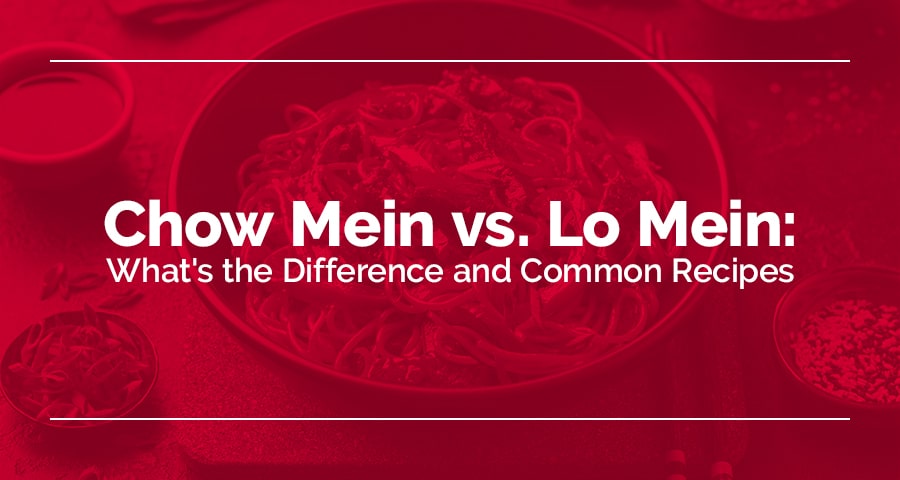Many people assume the distinction between chow mein and lo mein dishes is the kind of noodles used. This conclusion makes sense considering that chow mein noodles are delightfully crisp while lo mein noodles are silky smooth. However, what makes chow mein different from lo mein is how the noodles are prepared, not the type of noodle used.
To expand your Asian cuisine expertise, we’ll provide a breakdown of what chow mein is, what lo mein is and the culinary contrasts between the two popular dishes. We’ll also discuss how to make chow mein and lo mein with specific recipes for each dish so you can try making them at home.
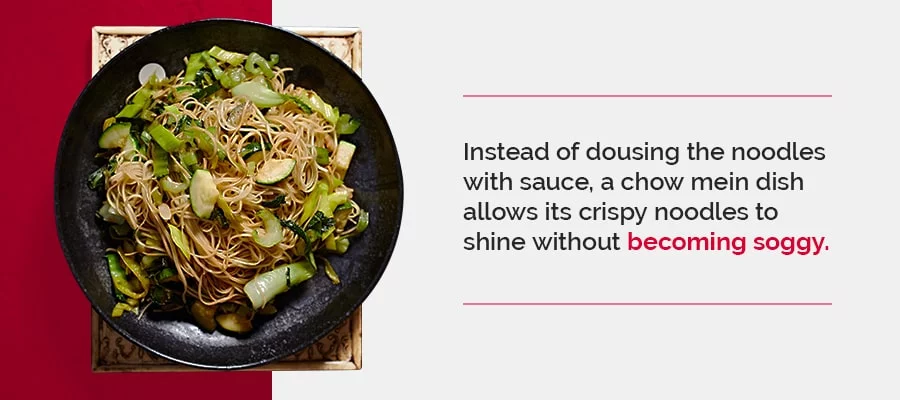
Table of Contents
What is Chow Mein?
What is Lo Mein?
Chow Mein vs. Lo Mein Noodles
How to Make Chow Mein
Chow Mein Recipes
How to Make Lo Mein
Lo Mein Recipes
Give Your Chow Mein and Lo Mein a Flavor Boost With SAN-J Tamari
What Is Chow Mein?
Chow mein is a popular Chinese noodle dish featuring fried noodles as the star of the dish. In general, the term chow mein refers to fried noodles.
What is a chow mein dish?
A classic chow mein dish is centered around the preparation of the noodles, which are the true highlight of the meal.The variations are endless, however there are two main types of chow mein dishes:
- Steamed chow mein: In steamed chow mein, the noodles are initially flash-fried, then stir-fried while being tossed with additional ingredients like meat or vegetables and coated in a light sauce.
- Crisp chow mein: When making crisp chow mein, the noodles are pressed flat while frying, creating a pancake-like dish. Any additional ingredients and sauces are layered on top of the noodle pancake.
In both styles of chow mein recipes, the noodles are the true star of the dish. Any extra vegetables or protein ingredients are kept to a minimum so they do not distract from the crunchy noodles. These accompaniments are added to the noodles only after the noodles have been boiled and fried in oil on their own, allowing the chef to solely focus on cooking the noodles to a crisp perfection.
Similarly, the sauce in a chow mein recipe is used sparingly. Instead of dousing the noodles with sauce, a chow mein dish allows its crispy noodles to shine without becoming soggy. Occasionally, crisp chow mein will be served with a darker, thicker sauce, which softens the crispy exterior of the noodles to create a chewier texture.
Here are some easy tricks to determine whether you’re eating chow mein:
- The noodles are distinctly crispy — in the case of crisp chow mein.
- The noodles are oily — in the case of steamed chow mein.
- The amounts of protein and vegetables are kept at a minimum.
- The sauce is lightly applied and does not overshadow or weigh down the noodles.
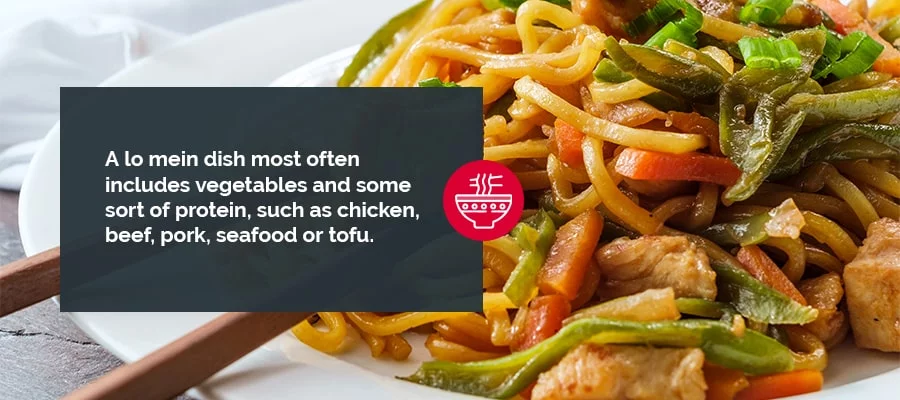
What Is Lo Mein?
At its root, lo mein simply refers to tossed or mixed noodles. Lo mein typically consists of fully cooked noodles that are tossed with a variety of vegetables, proteins, such as chicken, beef, pork, seafood or tofu and a flavorful sauce. The key to a delicious lo mein dish is the combination of textures and flavors from the fresh ingredients. In essence, lo mein is a dry variation of traditional noodle soup. To mimic the texture of soup, the chef drowns the noodle dish in a savory sauce.
Lo mein is made with fully cooked noodles that have been boiled and drained similar to how ramen, udon, and soba noodles are prepared. These cooked noodles are added to a wok containing various vegetables and proteins that have already been cooked and tossed in the lo mein sauce. All the ingredients are gently tossed together until the noodles are just heated through. At this point, some extra sauce may be drizzled over the wok to complete the dish.
If you’re unsure whether you are eating lo mein, look for these clues:
- The entire dish is generously coated with lo mein sauce to give it a bold, delicious flavor.
- The noodles are not greasy.
- The dish includes a considerable amount of veggies and protein, which have been mixed in with the noodles and sauce.
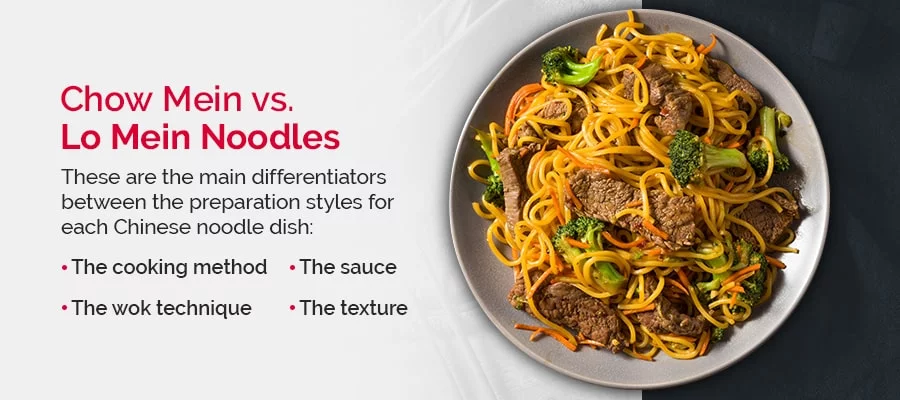
Chow Mein vs. Lo Mein Noodles
If you confuse chow mein for lo mein and vice versa, you’re not alone. It is easy to see the word “mein” and assume they are the same dish. However, “mein” simply means “noodles,” which means mixing up chow mein and lo mein is similar to confusing tortellini with ravioli — both culinary terms refer to a type of Italian pasta, but they are distinct.
In English, chow mein means fried noodles and lo mein translates to tossed or stirred noodles. Because both dishes are variations of the type of noodle, the main difference in chow mein and lo mein lies in how the noodles are prepared. These are the main differentiators between the preparation styles for each Chinese noodle dish:
Chow Mein vs. Lo Mein
- The cooking method: Although both mein recipes call for similar ingredients, the cooking methods for chow mein and lo mein are completely different. Chow mein noodles are soaked in hot water to soften them up before stir-frying. The process of stir-frying fully cooks the noodles along with the remaining ingredients. In contrast, lo mein noodles are completely cooked before getting mixed in with the meat, vegetables and sauce. Instead of getting stir-fried, the lo mein ingredients are lightly mixed and tossed.
- The wok technique: While both noodle dishes taste best when prepared with a wok, the way each is cooked in the wok differs. Making chow mein noodles involves using a small amount of oil in a very hot wok to lightly fry the ingredients while stirring briskly. For lo mein, the noodles are already cooked and are simply mixed and tossed with the rest of the ingredients instead of fried.
- The sauce: Chow mein is more of a dry noodle dish with an extremely light and delicate sauce — if any sauce at all. Lo mein is a saucy noodle dish that depends on a rich sauce for much of its flavor.
- The texture: Chow mein noodles tend to be crunchier than lo mein noodles due to the way they are cooked. Lo mein noodles are typically smoother and slightly chewier because they are fully cooked before being tossed with any extra ingredients and sauce. The noodles used to make a lo mein dish must also be thick and sturdy enough to support the weight of extra sauce.
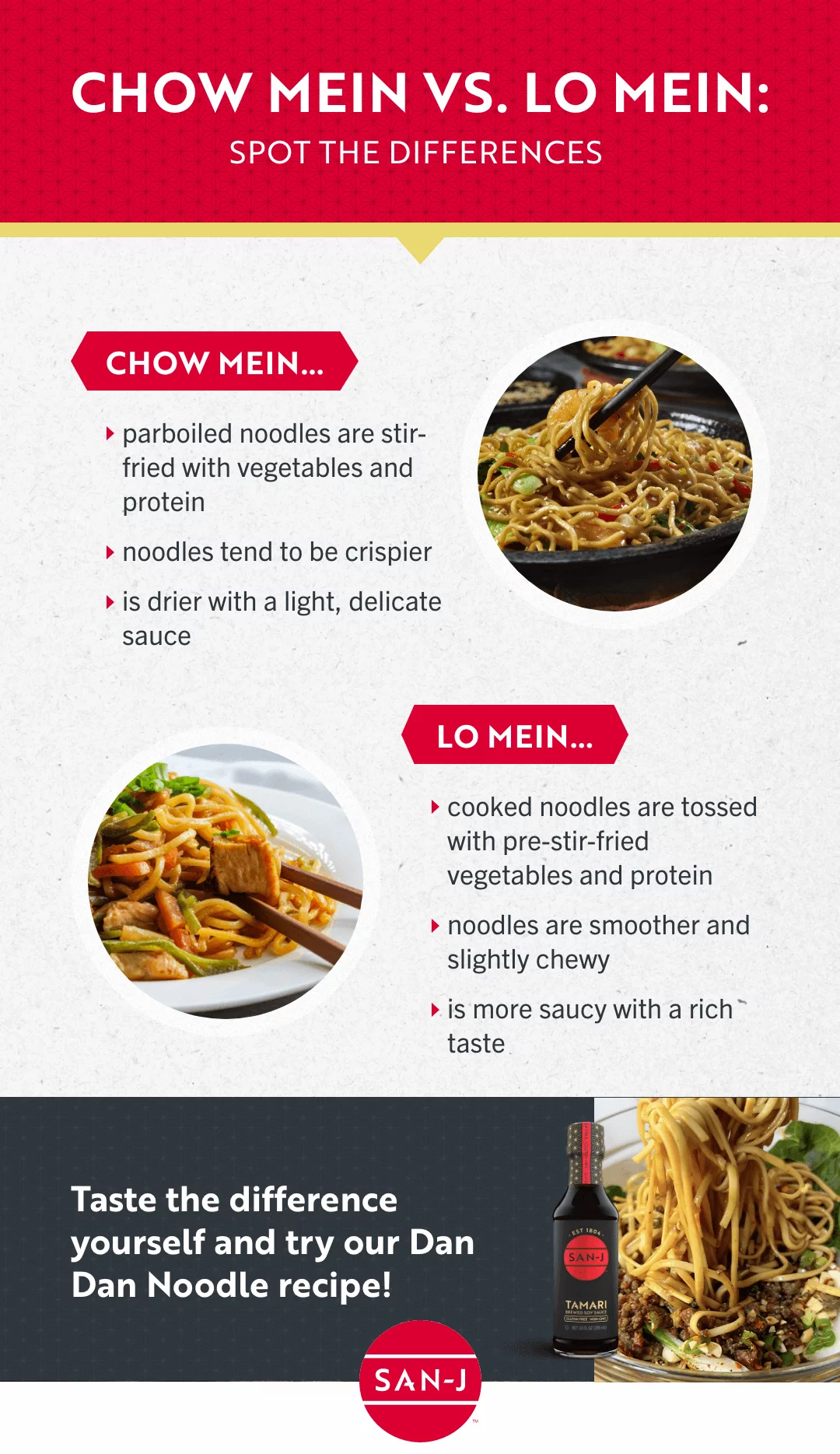
Types of Lo Mein Noodles
Despite their differences, chow mein and lo mein dishes are both made with Chinese egg noodles, which are wheat flour noodles with egg added. While lo mein requires fresh egg noodles, chow mein can be made with either fresh or dried egg noodles.
Regardless of whether you use fresh or dried egg noodles, you will need to soften the noodles in boiling water before cooking them. The goal of boiling the egg noodles is to get them to the point where they are just barely cooked, and not yet too soft. This texture is what is generally referred to as “al dente” in Italian cooking, which means “cooked to the tooth.”
Fresh egg noodles only need to be boiled for a couple of minutes, whereas dried egg noodles must be parboiled in boiling water for about five minutes before they’re ready to be cooked with. Keep in mind that the exact amount of cooking time will vary depending on the thickness of the noodles, so be sure to follow the package instructions for each kind of noodle.
If you are unable to find noodles that are specifically labeled as chow mein noodles or lo mein noodles, you can use linguine noodles, regular Italian spaghetti noodles, or another type of Asian noodle as a similar substitute.
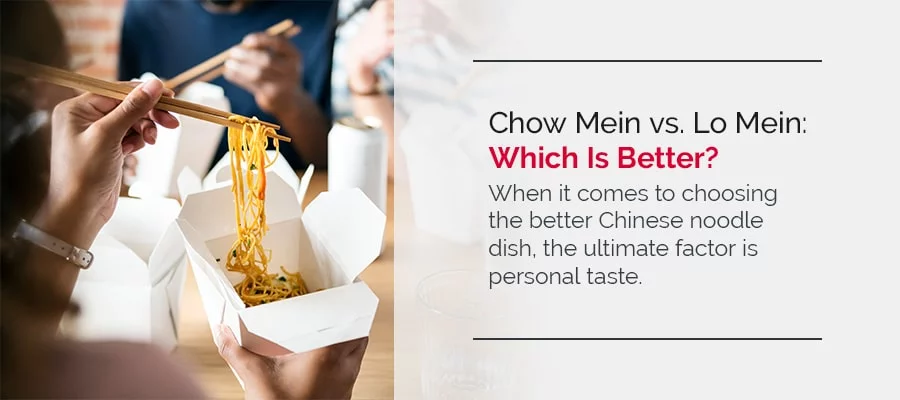
Chow Mein vs. Lo Mein: Which Is Better?
When it comes to choosing the better Chinese noodle dish, the ultimate factor is personal taste. While some noodle lovers enjoy the crunch of dried egg noodles expertly stir-fried into a delicious chow mein dish, others prefer a heaping bowl of steaming, sauce-soaked lo mein.
Your noodle texture choice will often depend on your other ingredients. Consider pairing crunchy chow mein noodles with softer ingredients like cooked mushrooms, juicy tomatoes and bean sprouts, and adding tougher ingredients like carrots, broccoli, celery and snow peas to your lo mein dishes.
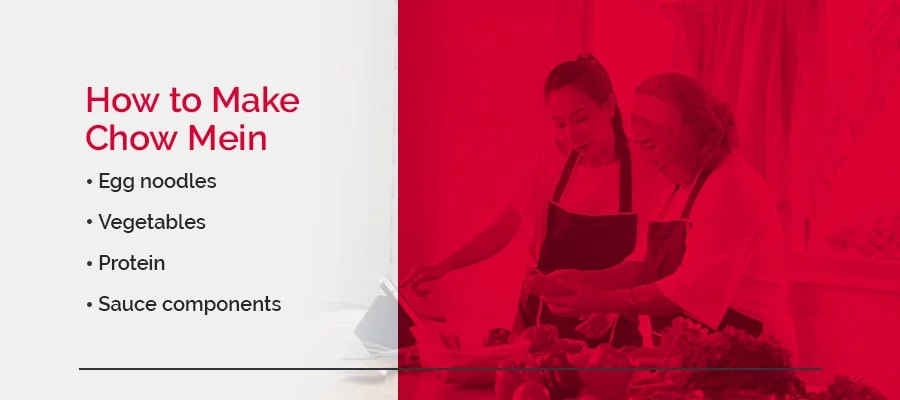
How to Make Chow Mein
If all this talk about chow mein and lo mein is making you hungry, you might want to know how to make these noodles dishes on your own. Before explaining how to whip up a batch of chow mein, let’s discuss why you should choose this chow mein recipe for dinner. Along with the delectable tastes and textures, here are some of the top reasons to make chow mein:
- Versatility: Like any other stir-fry, chow mein is incredibly customizable and allows you to switch up the vegetables and proteins as you please.
- Simple sauce: While chow mein sauce is unbelievably easy to make, it still brings a complexity of flavors to the dish. The careful combination of ingredients like soy sauce, sesame oil, oyster sauce and sugar results in a chow mein sauce that has hints of both savory and sweet notes.
- Quick and easy: Homemade chow mein is simple to prepare and the entire cooking process takes less time to complete than ordering takeout and picking it up or waiting for a delivery order to arrive.
- Disguised veggies: Thanks to a delicious blend of crunchy noodles and slightly sweet sauce, chow mein is the ideal noodle dish for sneaking in vegetables. Members of your family will be so focused on the yumminess of the noodles that they won’t notice nutritious additions like cabbage and bean sprouts.
Before you start cooking your chow mein, gather these chow mein noodles ingredients:
- Egg noodles: For chow mein, you can use fresh or dried egg noodles depending on what texture you want your dish to have. Make sure you use dried egg noodles if you want your chow mein to be crispy.
- Vegetables: Chow mein almost always features bean sprouts, shredded cabbage and chopped carrots. Usually, chow mein does not contain many other veggies, but you can feel free to add more.
- Protein: You can toss whatever type of protein you want into your chow mein. From chicken or shrimp to tofu or tempeh, just about any source of protein tastes good with chow mein. Chicken tends to be the most popular chow mein protein because it complements the broth in the sauce quite nicely.
- Sauce components: A standard chow mein sauce includes soy sauce, oyster sauce, light sesame oil, chicken broth, cornstarch and granulated sugar.
Be sure all your chow mein ingredients are chopped, prepped and ready to go before starting the cooking process because a hot wok cooks ingredients extremely fast. Although a wok is the best and most traditional way to prepare chow mein, you can use a regular skillet if you do not own a wok. Just make sure you use a skillet that is large enough to contain your noodles and other ingredients as you stir-fry them.
Follow these steps to ensure your chow mein is properly prepared:
- Start by boiling the egg noodles.
- As the noodles are cooking, whisk together your chow mein sauce ingredients.
- Cook any protein you’re using in a hot wok or skillet.
- After the protein is cooked through, saute your veggies in the wok.
- Once the noodles are ready, stir-fry them in the wok with the rest of the ingredients.
- Add the sauce to the wok and mix until the noodles are coated — only a minute or so.
- Remove from the wok and enjoy!
While the stir-fried noodles are the central focus of a chow mein dish, an excellently prepared sauce is what sets a stellar chow mein apart from an average chow mein. Enhance your chow mein sauce by using a high-quality soy sauce that will give your dish a deeper savory quality and more layers of complex flavors. Try using Tamari — a rich, dark soy sauce — as your secret weapon for making a wow-worthy chow mein. Try SAN-J’s Organic Tamari Soy Sauce and 50% Less Sodium Soy Sauce in your chow mein.
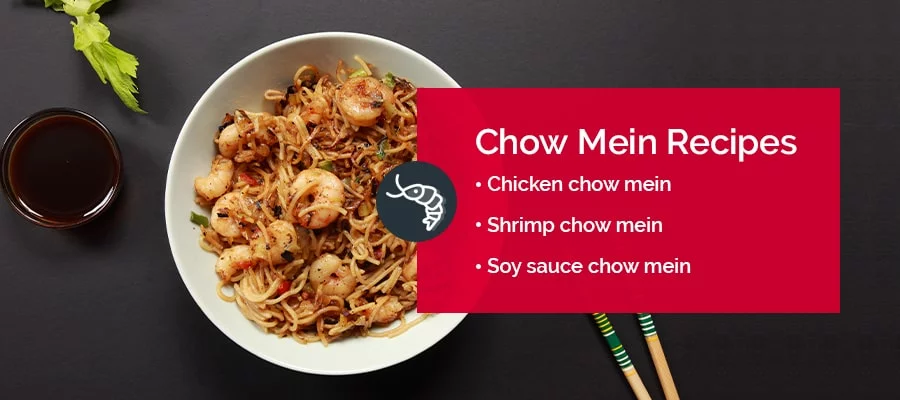
Popular Chow Mein Recipes
For a more precise set of ingredients, try one of these traditional chow mein recipes:
- Chicken chow mein: Chicken chow mein is an iconic Chinese takeout dish. You can whip up your own chicken chow mein in minutes by following the chow mein instructions above and using chicken, shredded cabbage, julienned carrots and green onions as your add-ins.
- Shrimp chow mein: Have a seafood lover in your household? Shrimp chow mein will surely become a new dinnertime favorite for anyone who enjoys seafood and Chinese cuisine. Simply combine shrimp, cabbage, carrots and bean sprouts with your chow mein noodles to create this delicious dish.
- Soy sauce chow mein: Ready to let your chow mein sauce-making skills shine? A simple soy sauce chow mein seasons plain fried egg noodles with a mouthwatering blend of light soy sauce, dark soy sauce, oyster sauce, sesame oil, sugar, white pepper and Shaoxing wine.
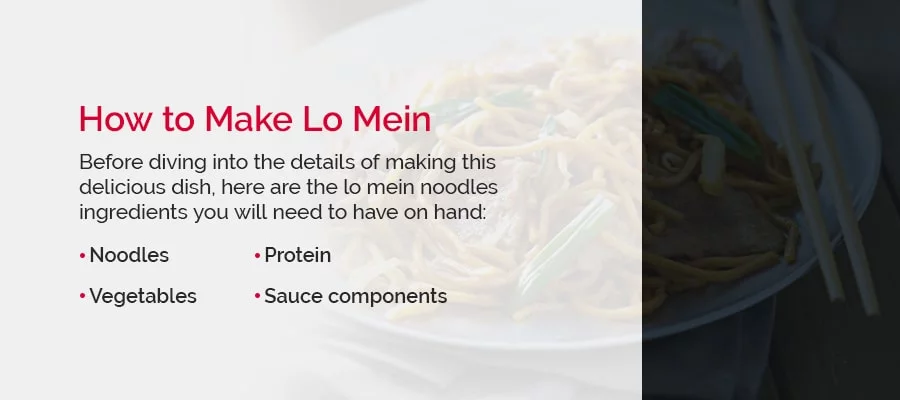
How to Make Lo Mein
Lo mein offers all the same benefits as chow mein — versatility, a simple sauce, quick and easy cooking and disguised vegetables — but follows a slightly different cooking method. For lo mein, noodles are not fried. Instead, fully cooked egg noodles are tossed with pre-stir-fried vegetables and protein. Lo mein is also loaded with more sauce to stick to the soft, plump noodles.
Before diving into the details of making this delicious dish, here are the lo mein noodles ingredients you will need to have on hand:
- Noodles: For the best results, use fresh egg noodles. If you’re in a pinch, you can substitute virtually any other type of long noodle for your lo mein.
- Vegetables: Lo mein typically includes sturdier veggies like broccoli, bell peppers, sliced zucchini and carrots. You can also sprinkle in some chopped onion, green onion and garlic for an extra pop of flavor to your vegetable lo mein.
- Protein: Nearly any protein goes well with lo mein. Most commonly, lo mein involves chicken, beef, pork, turkey, shrimp or tofu.
- Sauce components: Lo mein sauce is mainly composed of sesame oil, light soy sauce, dark soy sauce, garlic, ginger, oyster sauce and a dash of sugar. If you like your noodles to have a little heat, you can sprinkle in some red pepper flakes.
Once you’ve assembled your ingredients, follow these steps to make the perfect lo mein:
- Boil and drain the egg noodles.
- Make your lo mein sauce by whisking all the ingredients together.
- Stir-fry the veggies and protein in a hot wok or heavy-based skillet. Incorporate a bit of the lo mein sauce while you’re cooking the veggies and protein to season them even more. Make sure you only cook the veggies until they are just cooked on the outside and still a bit raw in the center — overcooked veggies will leech water, which waters down the sauce’s flavor.
- Add the egg noodles and sauce to the wok.
- Use two wooden spoons to toss the noodles with the sauce and other ingredients. Work quickly and constantly stir so the noodles do not become overcooked, watery or soggy.
- Remove from the wok as soon as the noodles are coated, plate and enjoy!
The defining feature of any lo mein dish is the sauce, so make sure you take the time to get it right. Using dark soy sauce will give the lo mein color and a bolder taste while adding light soy sauce will give the dish some extra saltiness and flavor without staining the noodles darker. For a more intense savory flavor, consider using Tamari, which uses more soy protein to create a richer, more complex taste.
Because the sauce is the star ingredient of lo mein, this dish will be drenched in much more sauce than chow mein. The thick and chewy fresh egg noodles perfectly complement the lo mein sauce by soaking up the sauce. These plump and soft noodles are also suitable for wrapping around chopsticks, making them the ideal lo mein noodle.
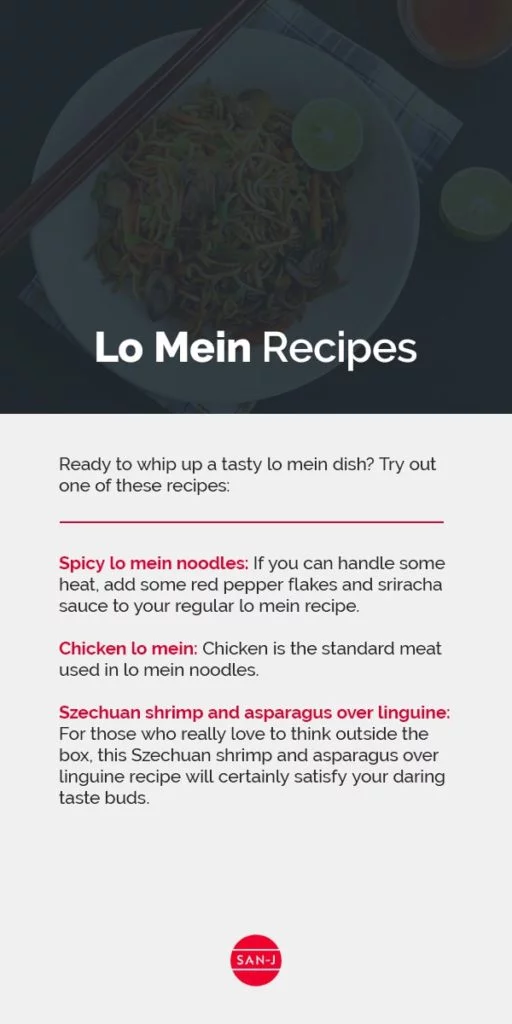
Popular Lo Mein Recipes
Ready to whip up a tasty Chinese lo mein dish? Try out one of these recipes:
- Dan Dan noodles: If you’re looking for a dish with some heat, this Dan Dan noodles recipe is perfect as it incorporates Sichuan peppercorns and chili oil. You can also zest up your lo mein’s flavors by using a splash of Chinese cooking wine in its sauce.
- Chicken lo mein: Chicken is the standard meat used in lo mein noodles. If you’re looking for a little extra protein with your noodles and want to try a classic Chinese takeout dish, add some stir-fried chicken to your lo mein. Be sure to cook the chicken in the lo mein sauce to take the dish’s flavors up a notch.
- Szechuan shrimp and asparagus over linguine: For those who really love to think outside the box, this Szechuan shrimp and asparagus over linguine recipe will certainly satisfy your daring taste buds. Adding a touch of SAN-J Szechuan Sauce to this lo mein-style recipe fills the dish with impactful flavors, while using linguine gives it a unique texture.
Give Your Chow Mein and Lo Mein a Flavor Boost With SAN-J Tamari
If you want your homemade chow mein or lo mein to taste better than takeout, use our Tamari Soy Sauce to enhance your noodle recipe. The savory complexity of our Tamari Soy Sauce will bring out the other flavors in your dish while adding a distinct richness to your meal. Our Tamari Soy Sauce is also Non-GMO verified by the Non-GMO Project, certified gluten-free by the Gluten-Free Certification Organization, certified vegan and certified kosher, so you can feel good about adding it to your dish.
Get one step closer to the chow mein or lo mein of your dreams by exploring our variety of SAN-J Tamari products and our other recipes! Purchase your SAN-J Tamari today, and contact us with any questions.
Back to Top
